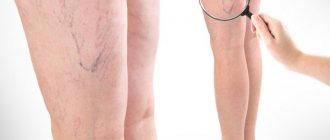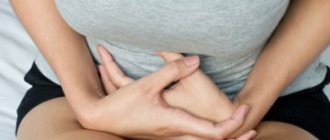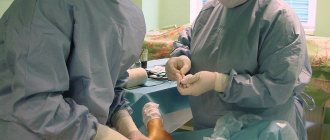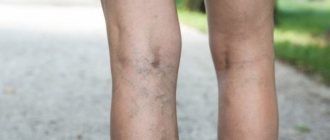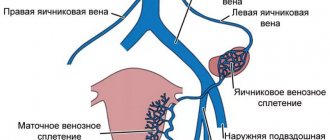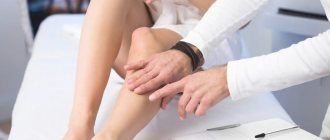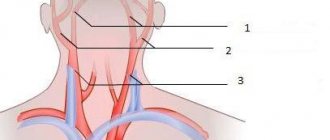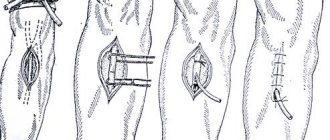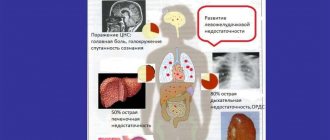Why does this happen?
It is important to be able to distinguish in which case this symptom is a variant of the norm, a physiological condition, and in which it is pathological, requiring diagnosis and treatment.
This is what it looks like in the photo:
In ordinary healthy people
As a normal option, large swollen veins in the arms may appear in the following situations:
- A person regularly performs strength physical activity on his hands. In this case, the pressure on the vessels increases, expanding their lumen, and at the same time, the arm muscles become hard - they also help push the veins out.
- From the blow. The site of the bruise usually swells, the vessel becomes more noticeable and pronounced. If a person hits his hand right in the place where the vein passes, then it may swell, turn blue or purple, sometimes even turn black and a bruise will form around it.
- Thin, translucent skin (especially in girls, teenage boys and children), with a small layer of subcutaneous fat that could hide blood vessels. Normally, this problem should not cause cosmetic defects in a child.
- A hereditary feature is the superficial location of the veins. Most often, enlarged veins appear after too much physical exertion or when a person holds for a long time and then quickly lowers his hands. It occurs less frequently in boys than in girls.
- Hot weather, significant increase in air temperature. This factor sometimes provokes increased blood pumping in the extremities, due to which the vessels and capillaries increase in size, inflate and become convex (on the legs this manifests itself as varicose veins and swelling in the evenings).
- In older people, as a result of the aging of the body. With age, the elasticity of blood vessels begins to be lost, the walls of the veins are unable to maintain their shape, and the tortuous pattern on the hands becomes more noticeable.
- Pregnancy, postpartum period. In this condition, bulging veins in women is a physiological process associated with hormonal changes in the body.
- Blood collection, IV placement, anesthesia administration. In some people, the veins may swell after a blood donation procedure, or after a catheter is removed. In this case, the injection site often ache, itch, and there is redness and burning. This is an absolutely normal phenomenon that is associated with anatomy, there is no need to worry. But if there is also pain, you should consult a doctor, this may be a sign of post-injection phlebitis.
- When you lower your hands. A similar phenomenon is usually observed in people with problems with blood pressure, with increased blood density. When the arms are lowered, especially if they had been raised for a long time or were tense, the blood does not have time to circulate normally and the veins become more visible.
If the veins swell and then disappear, this may indicate a temporary circulatory disorder. In this situation, there is no point in trying to reduce them; they must hide on their own.
In athletes
In people who are actively involved in sports, veins appear much more often than in others. For example, in bodybuilders and bodybuilders, increased venousness and pulsation is due to the fact that during training the athlete’s arms bear a huge load - the vessels from the inside bulge from the muscles, which grow rapidly.
Another option is if the vessels of the upper or lower extremities swell immediately after training. This happens because physical activity increased blood flow and expanded the lumen of the vessels, which then come to the surface.
Due to illness
Pathological reasons for swollen veins in the arms are less common than physiological ones, but they should not be ignored. It is important to exclude in time a possible disease that will cause not only aesthetic inconvenience, but also possible serious complications in the future.
Most often, diseases that provoke such a symptom are:
- Varicose veins. It occurs when the walls of blood vessels weaken, causing congestion to clog them, causing them to swell and bulge under the skin.
- Thrombosis. With this disease, blockages (one or more) appear in the deep veins, which form a blood clot. The pathology is quite difficult to identify in the early stages, while the superficial vessels have not yet emerged; it is practically not accompanied by symptoms. From time to time a person may feel heaviness in the limbs and pain when palpated.
- Thrombophlebitis. This is an inflammatory process of the walls of superficial blood vessels. They become dark blue, in advanced cases they turn black and are very painful.
- Postphlebitic syndrome. A pathology characterized by a complication of deep vessel thrombosis.
All these diseases require timely treatment. If neglected, they threaten serious damage to the arteries, atrophy of part of the bloodstream and paralysis of the limbs.
Is it possible to get rid of swollen veins using folk remedies?
There are many traditional methods that can help relieve swelling from the hands. Basically, they can only be used when a person feels pain that interferes with sleep at night. It is important to understand that such remedies will not be able to completely eliminate the cause and it is better not to postpone a visit to the doctor.
Varicose veins on the arms, how to get rid of pain:
- Green tomato compress. To prepare it, you will need to cut one tomato into small slices and place evenly on the affected vein. Then, wrap everything with a bandage and leave until the morning. Many people claim that with the help of such a compress you can get rid of varicose veins forever.
- According to the second method, you need to crush a couple of cloves of garlic and mix the resulting mass with 50 g of butter. The resulting garlic ointment is applied in a thin layer to the skin where the diseased vein is located. Then they wrap the top with parchment paper and wrap it with a bandage. This method is also used at night and removed in the morning. Garlic ointment helps relieve pain, and with regular use, after a couple of months, varicose veins disappear completely.
- Flowering wormwood mixed with yogurt also copes well with pain. Just take a glass of yogurt and add 2 tbsp. spoons of finely chopped wormwood flowers. The prepared mixture is applied to the diseased vein for 30 minutes. Then remove and brush with heavy cream.
All of the above methods will perfectly cope with pain. As for therapeutic therapy, it is better to contact a competent specialist with this question. You should not engage in “shamanism”, since such tactics can lead to irreparable consequences.
Associated symptoms
In the case of pathological provoking factors, pronounced veins usually cause not only aesthetic, but also physical discomfort.
This mainly manifests itself:
- heaviness and pain in the hands;
- swelling of the hands.
One of the common symptoms is a constant desire to fix the arms above the level of the head (in this position, the outflow of stagnant blood improves).
In difficult cases, when vein pathology is caused by serious circulatory disorders, as well as thrombophlebitis, the following is observed:
- slight increase in body temperature;
- hyperemia of the skin of the hands;
- lump, lump, lump, swelling or ball at the site of the lesion;
- swelling, blueness;
- change in skin color;
- muscle weakness;
- the appearance of ulcers on the skin.
Treatment: what to do if the veins in your arms disappear
The condition of the circulatory system can be improved using preventive methods. It is important to exercise regularly, lead an active lifestyle and eat right. It is better to exclude alcohol and nicotine. Synthetic drugs are prescribed only after appropriate diagnosis and determination of the disease. Vasodilator medications are prescribed if necessary. In the case where the veins have disappeared during the installation of a catheter, blood sampling or injection, the limb is bandaged with a rubber tourniquet, above the point where the needle enters. If the doctor determines that the cause of such a feature is a disturbance in the functioning of the cardiovascular system, it is important to begin treatment of the factors that provoked such a deviation. Self-medication with folk remedies can cause irreparable harm to human health.
Treatment tactics
Treatment of any pathology depends on the cause that provoked it. Therapeutic measures for pronounced veins can be medicinal and surgical.
The last option is resorted to in two cases: either if the disease progresses and there is a risk of a large blood clot, or if the patient simply wants to eliminate an aesthetic defect.
| Cause of Vein Swelling | Therapy |
| Thrombophlebitis | Antiplatelet agents and anticoagulants, anti-inflammatory drugs, warm compresses. |
| Hereditary predisposition | An aesthetic problem that is inherited can only be eliminated through surgery. |
| Increased physical activity | Moderate exercise or temporary refusal of it will make the veins less noticeable. |
| Varicose veins | Surgical intervention or conservative treatment. |
General recommendations
To enhance the effect of drug or surgical therapy, you need to help the body remove (hide) visible veins.
For this:
- Drink enough clean, non-carbonated water. This will improve the structure of the skin of your hands, it will become smoother and more elastic.
- Avoid coffee and alcohol. This will make the skin color uniform, without a “gray” tint.
- Use hand creams. This can be either a simple moisturizer or a special anti-varicose cream. The latter will improve the tone of blood vessels, and, if the problem has not gone far, will hide them.
Hand exercises
There is a whole list of exercises (pictured below) that will help eliminate large veins.
Here are the most effective:
- Clasp your hands into fists, lower and raise them “all the way”, bending your hands – 10 times.
- Alternately extend your fingers to the back, then together.
- Gather the fingers of the right and left hands into a bun, lower them together downwards, bending the hand, return to the starting position - 10 times.
- Work your thumbs: pull them back and forth and to the sides.
- Clenching your hands into fists, twist them, bending your wrist.
- Forcefully bend and straighten your fingers into fists – 10 times.
- Place your palms together in front of your chest, bend your arms at the elbow joints, raise your elbows up, lowering your hands to your navel.
- Walk along any surface with your fingers, imitating playing the piano.
- Straighten your arms, point them in different directions, swing them in a circle - forward and backward.
- In the same position, bend your elbows and make circular movements of your limbs, first to the right, then to the left.
Such exercises, performed daily, can really improve the aesthetic appearance of the hands by restoring the tone of the blood vessels.
Drug therapy
Conservative treatment is aimed not only at eliminating the visible defect, but also at stopping the cause that caused it.
Basically, doctors prescribe:
| A drug | Group | Action |
| Venobene, Troxevasin, Dolgit | Local application | Relieves pain |
| Dipyridamole, Clopidogrel, Aspirin, Cardiomagnyl | Antiplatelet agents | Reduce the risk of blood clots, improve blood flow |
| Urokinase, Fibrinolysin, Trypsin | Fibrinolytics | Thinning blood, preventing blood clots |
| Trental, Pentoxifylline | Improved blood circulation | Prevents blood stagnation in the extremities, vasoconstriction |
| Ibuprofen, Ketonal, Dicloberl, Meloxicam | NSAIDs (non-steroidal anti-inflammatory drugs) | Relieves inflammation and pain |
Remember that you should never prescribe medications and treatment for yourself! This label is provided for informational purposes only.
Physiotherapeutic procedures
Among the physiotherapeutic procedures that can help are taking a contrast shower twice a day for at least 10 minutes, and massage. It can even be done independently, at home, either with your hands or with the help of various massage devices. For dry skin, you should use cosmetic oil.
Hand baths (used in nail salons) are also used. Modern models are equipped with an infrared emitter; it is possible to conduct a session of magnetic therapy and vibration massage. Such comprehensive care will definitely improve the appearance of the hand area, relieve fatigue and relax them.
When is surgery required?
If, as a result of the course of the disease, the veins are very prominent, and drug treatment has no effect, then the patient will definitely undergo surgery. If there are no pathologies, but bloating is observed for some non-serious reasons, for example, as a result of heredity, then everything depends only on the desire of the patient himself.
There are several surgical options:
- Phlebectomy. This is the complete removal of a vein affected by varicose veins using special instruments.
- Sclerotherapy. This type of surgical intervention involves turning off the vein from the bloodstream (its functions are assigned to other vessels) and filling it with a special sclerotic fluid.
- Laser therapy. Veins that are swollen disappear under the influence of a laser, which glues them together from the inside. This is the most painless and gentle operation.
- Ultrasound thrombolysis. It is used if a blood clot has formed in the bloodstream. Then, with the help of a certain wavelength, it is destroyed.
Depending on the chosen surgical procedure, the rehabilitation period will vary. The shortest is with laser therapy, the longest is with phlebectomy. In the latter case, hands should not be subjected to heavy physical effort for a month.
Alternative Therapies
If the veins become very enlarged and protrude, but there are no blood clots or a threat to health, alternative medicine can come to the rescue. This is a whole set of folk recipes, treatment with leeches, acupuncture.
Important: before deciding on unconventional methods of treatment, you need to consult a doctor and make sure that the chosen method will not harm or aggravate the situation. Poor patient tests will be the first contraindication for the use of alternative medicine methods.
Reviews from doctors about alternative medicine are mixed, but all experts agree that they can only be used when there are no blood clots or visible varicose veins.
Folk recipes
We bring to your attention popular recipes for folk remedies that can help with swollen veins in the hands:
- Take a green tomato (according to the degree of ripeness), cut it into slices, place it on your hand in the place where the veins emerge and swell, and wrap it with an elastic bandage overnight. In the morning, remove everything and spread the skin with a high-fat cream.
- Mix crushed wormwood (3 tablespoons) with the same amount of curdled milk, smear the resulting medicine on your hand and wrap it in cling film. After 20 minutes, remove the compress and spread the skin with rich cream or sour cream. This will take up to a month.
- Apple cider vinegar and birch bud tincture are mixed 1:1, rub your hands with the resulting mixture twice a day.
- Chopped garlic and butter in equal proportions are mixed and applied to the hands in places where the veins are swollen. The compress needs to be insulated as much as possible (using cling film and a towel on top). You will have to smear visible veins for up to 5 months.
- Drink herbal tea: rose hips, blueberry leaves, rowan berries and St. John's wort are mixed in equal parts. Take half a glass twice a day, brewing a tablespoon of the resulting tea with boiling water.
Hirudotherapy
Treatment with leeches is practiced even with pronounced veins, when the hands swell from insufficient blood outflow.
The essence of hirudotherapy is that a specially grown medical leech is placed on a patient at a certain point on the body. During the bite, a substance, hirudin, enters the blood, which thins it and prevents blood clots.
Patients note an improvement in the appearance of their hands and overall well-being after the first session. After manipulation, the leech is placed in medical alcohol.
Acupuncture
Using this method, certain points of the human body are affected by introducing special thin needles into them. They activate biological processes in the body, thereby restoring normal blood flow and preventing congestion.
This method is not recommended for everyone, as it has a number of contraindications. Before deciding to go to an acupuncture session, you need to take all the tests and notify your doctor.
Features during pregnancy
When carrying a baby, many changes occur in the female body. Varicose veins during pregnancy are not uncommon and worry almost every expectant mother to one degree or another. A woman may notice that veins have swelled in her arms or a ball-shaped lump has formed. This condition is associated with an increased amount of blood, which is more difficult to circulate. Due to its increased volume, stagnant processes often occur.
During pregnancy, the disease may appear due to hormonal imbalance.
Hormonal imbalances in the body can also affect dilated veins in the arms during pregnancy. During this period, more progesterone is produced, which affects the elasticity of the vascular walls, increasing their elasticity. When blood vessels dilate excessively, the load on the valves increases, which leads to a malfunction of their function. As a rule, no special treatment is required, only systematic monitoring is important. If necessary, medications are prescribed. Radical therapy for varicose veins in the arms when carrying a baby is extremely rare. After the birth of the child, the problem goes away on its own, the veins return to normal tone and cease to be noticeable.
Prevention
Preventive measures aimed at preventing the swelling of veins on the surface of the skin of the hands come down to reasonable exercise and a healthy lifestyle.
They include:
- charging;
- quitting smoking, alcohol and coffee;
- taking a contrast shower;
- balanced diet.
Author of the article: Yulia Dmitrieva (Sych) - In 2014, she graduated with honors from Saratov State Medical University named after V. I. Razumovsky. Currently working as a cardiologist at the 8th City Clinical Hospital in the 1st clinic.
What tests need to be taken?
If the patient has other dangerous signs indicating varicose veins, he should first consult a phlebologist. The doctor will examine the patient (palpation) and, if necessary, prescribe additional research methods.
The results of tests and examinations will help identify the cause.
Laboratory tests are considered mandatory. The following methods are used to diagnose vascular diseases:
- Blood test (general).
- Urine examination.
- Biochemical blood test (to determine cholesterol and other parameters).
- Blood test for clotting.
These tests will help evaluate the properties of the blood and diagnose possible vascular diseases.
Necessary examinations
You can diagnose possible diseases that provoked swelling of the veins in the arms and pain in them using additional diagnostic methods. These include:
- Segmental Dopplerography.
- Magnetic resonance imaging of veins.
- Computed tomographic phlebography.
- Ultrasound diagnostics of vessels of the upper extremities.
The most modern diagnostic method for the occurrence of symptoms of varicose veins and phlebitis is duplex sonography. The procedure does not last long (about fifteen minutes), but allows you to assess the condition of the deep and superficial veins.


